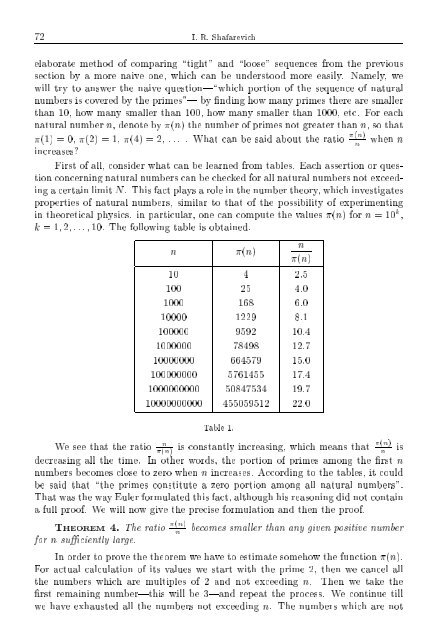SELECTED CHAPTERS FROM ALGEBRA I. R. Shafarevich Preface
SELECTED CHAPTERS FROM ALGEBRA I. R. Shafarevich Preface
SELECTED CHAPTERS FROM ALGEBRA I. R. Shafarevich Preface
You also want an ePaper? Increase the reach of your titles
YUMPU automatically turns print PDFs into web optimized ePapers that Google loves.
72 I. R. <strong>Shafarevich</strong>elaborate method of comparing \tight" and \loose" sequences from the previoussection by a more naive one, which can be understood more easily. Namely, wewill try to answer the naive question|\which portion of the sequence of naturalnumbers is covered by the primes"| by nding how many primes there are smallerthan 10, how many smaller than 100, how many smaller than 1000, etc. For eachnatural number n, denoteby (n) thenumber of primes not greater than n, sothat(1) = 0, (2) = 1, (4) = 2, . . . . What can be said about the ratio (n)nwhen nincreases?First of all, consider what can be learned from tables. Each assertion or questionconcerning natural numberscanbechecked for all natural numbers not exceedinga certain limit N. This fact playsaroleinthenumber theory, whichinvestigatesproperties of natural numbers, similar to that of the possibility of experimentingin theoretical physics. in particular, one can compute the values (n) for n =10 k ,k =1 2 ... 10. The following table is obtained.n(n)n(n)10 4 2.5100 25 4.01000 168 6.010000 1229 8.1100000 9592 10.41000000 78498 12.710000000 664579 15.0100000000 5761455 17.41000000000 50847534 19.710000000000 455059512 22.0n(n)Table 1.(n)We see that the ratio is constantly increasing, which means thatnisdecreasing all the time. In other words, the portion of primes among the rst nnumbers becomes close to zero when n increases. According to the tables, it couldbe said that \the primes constitute a zero portion among all natural numbers".That was the way Euler formulated this fact, although his reasoning did not containa full proof. We will now give the precise formulation and then the proof.THEOREM 4. The ratio (n)nbecomes smaller than any given positive numberfor n suciently large.In order to prove the theorem we have to estimate somehow the function (n).For actual calculation of its values we start with the prime 2, then we cancel allthe numbers which are multiples of 2 and not exceeding n. Then we take therst remaining number|this will be 3|and repeat the process. We continue tillwe have exhausted all the numbers not exceeding n. The numbers which are not
















